When it comes to whisky nosing, I start by selecting the right glassware, typically a tulip-shaped glass, which helps concentrate the aromas. Next, I create an ideal environment by controlling lighting and minimizing extraneous odors. Then, I gently swirl the whisky to release the complex bouquets. By using techniques like mouth breathing and deep sniffing, I'm able to reveal nuanced notes of fruit, spice, and oak. To take it to the next level, I avoid scent contamination by using separate glasses for each whisky.
Choosing the Right Glass
When it comes to selecting a glass for whisky nosing, a tulip-shaped design is key. This unique shape concentrates the aromas, providing a superior sensory experience. The curved shape of the glass funnels the whisky's volatile compounds directly to the nose, making it easier to appreciate the complex flavors. In contrast, wide-rimmed glasses are not ideal, as they disperse the aromas, reducing the sensory experience.
To get the most out of your whisky nosing experience, it's crucial to keep your glass clean. Any residue can interfere with the delicate balance of aromas, so make sure to wash your glass thoroughly with water before use.
The way you hold the glass also matters. By gripping the base of the glass, you can preserve the whisky's temperature, which is vital for maintaining its intended flavors and aromas. This small detail can make a significant difference in the nosing process.
Gently swirling the whisky in the tulip-shaped glass is another important step. This action releases the whisky's complex aromas, allowing for a more detailed analysis. By combining the right glass with these careful techniques, you can create an optimal sensory experience and truly appreciate the art of whisky nosing.
Preparing Your Environment
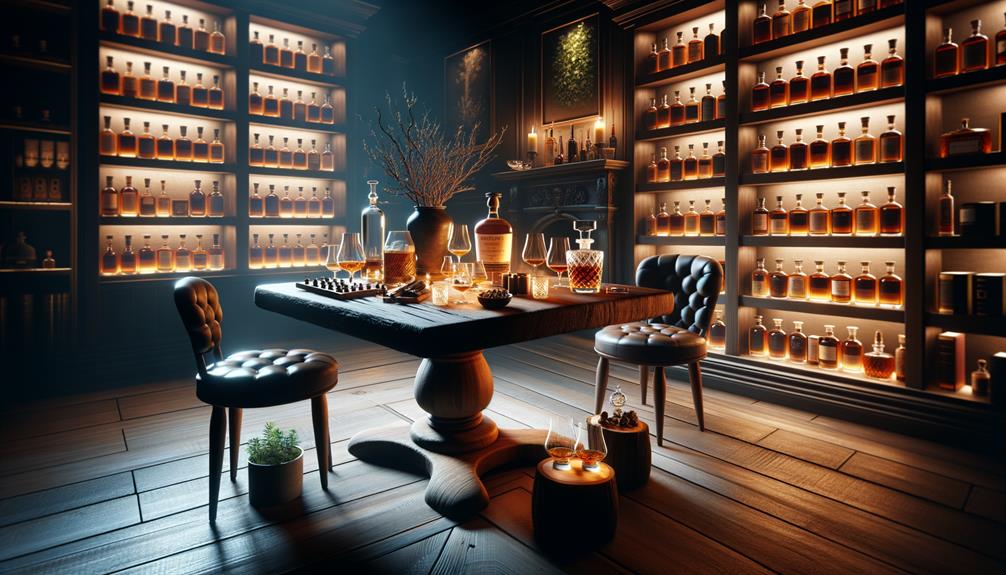
When I'm preparing for a whisky nosing session, I take great care to control my environment. I use a tulip-shaped glass to concentrate the aromas and avoid overpowering scents. I also ensure the lighting is ideal, so I can clearly see the whisky's color. By managing these factors, I create the perfect setting to fully appreciate the complexity of the whisky's bouquet.
Choose Proper Glassware
Selecting the right glassware is crucial for a truly immersive whisky nosing experience. A tulip-shaped glass is perfect for capturing and directing the complex aromas upwards, allowing me to detect even the subtlest notes. Wide-rimmed glasses, on the other hand, can disperse these precious aromas, making it difficult to fully appreciate the whisky's bouquet.
Cleaning my glassware properly is vital. I always rinse my glass with water before nosing to prevent any residual contaminants from interfering with the whisky's profile. This step ensures a pure, unadulterated sensory experience.
When handling the glass, I make sure to hold it by the base. This technique helps maintain the whisky's temperature, which is essential for preserving the integrity of its aromas. Holding the glass by the bowl can warm the whisky prematurely, causing evaporation and loss of aromatic compounds.
Before bringing the glass to my nose, I gently swirl the whisky. This action releases the aromas, preparing them for a thorough examination. By combining proper glassware, meticulous cleaning, and precise handling techniques, I can transform the nosing process into an exquisite and innovative sensory journey.
Control Lighting Conditions
To accurately evaluate whisky aromas, I ensure my environment has consistent and suitable lighting conditions. While bright or natural light can be beneficial for observing the whisky's color, it can also interfere with my ability to perceive the aromas. To find the perfect balance, I experiment with different lighting setups.
I find that dim lighting works best for me, as it reduces distractions and allows me to focus on the whisky's subtle scents. This subdued atmosphere helps me detect nuanced aromas that might otherwise be overshadowed in brighter conditions. However, I avoid harsh lighting that can create glare on the glass and hinder my ability to discern these delicate notes effectively.
I aim for soft, ambient light that illuminates the whisky just enough without causing reflections. By carefully controlling the lighting conditions in my environment, I can have a more precise and enjoyable nosing session. By fine-tuning the lighting, I can maximize my perception capabilities, ensuring that I can fully appreciate the complexity and depth of each whisky's aromatic profile.
Manage Surrounding Odors
To truly experience the nuances of whisky, I take great care to eliminate any strong surrounding odors that could interfere with my nosing session. The room needs to be neutral, free from perfumes, cooking smells, and other intrusive scents. Good ventilation is crucial; it helps dissipate any lingering smells that might muddy the whisky's delicate aromas.
I avoid smoking before or during the nosing session, as tobacco smoke can overwhelm my senses and compromise my ability to detect aromas accurately. A simple, unscented candle can be a useful tool – lighting it can help neutralize any residual odors, creating an ideal environment for nosing.
These steps are crucial because they allow me to fully appreciate and differentiate the complex aromas of the whisky. A clean, odor-free space is not just about comfort – it's about precision and authenticity in whisky appreciation. By controlling the scents around me, I ensure that my nosing experience is as authentic and enriching as possible, capturing the whisky's true essence.
The Initial Nosing
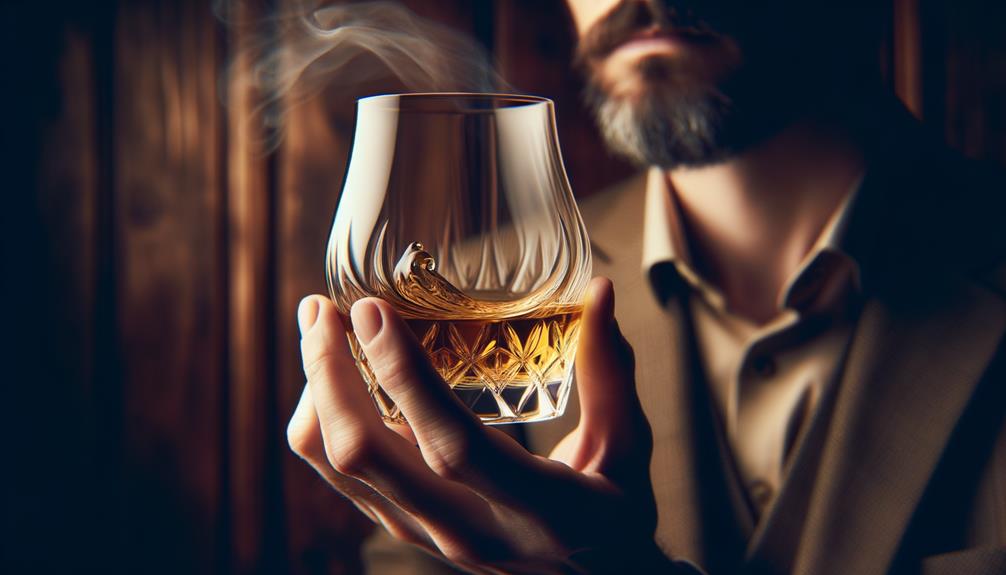
When I start nosing a whisky, I choose the right glass, usually a tulip-shaped one, to focus the aromas. I gently swirl the whisky, bringing the glass to my nose for a slow, deep inhale to capture the first impressions. I note the immediate scents – whether they're sweet, fruity, smoky, or spicy – and consider how they change with each subsequent inhale.
Glassware Selection
When it comes to selecting the ideal glassware for nosing whisky, a tulip-shaped glass is the way to go. This type of glass concentrates the aromas, allowing you to fully appreciate the whisky's scent profile.
Wide-rimmed glasses, on the other hand, disperse the aromas too broadly, watering down the scent profile and diminishing the sensory experience.
When it comes to preparing your glass for nosing, keep the following tips in mind:
Clean your glasses with water to prevent any contamination that could interfere with the pure nosing experience. Hold the glass by its base rather than the bowl to maintain the whisky's temperature and preserve its aromatic qualities. Before nosing, gently swirl the whisky in the glass to release the full range of aromas and flavors, priming the whisky for a detailed sensory analysis.
Nosing Techniques
As I gently swirl the whisky in my tulip-shaped glass, I prepare to take a slow, deliberate inhale to capture the initial burst of aromas. This is where my journey begins. The swirling action releases volatile compounds, allowing a spectrum of aromas to surface. I bring the glass to my nose, taking a deep breath to note the initial scents that stand out. Often, I detect hints of fruit – perhaps ripe apples or dried apricots – followed by the alluring presence of spices like cinnamon or nutmeg. The subtle yet unmistakable aroma of oak also seeps through, a sign of the whisky's aging process.
I pay close attention to the intensity of these aromas. Are they bold and assertive, or more delicate and nuanced? This initial nosing sets the stage for the whisky's complex aroma profile to evolve. As I continue to nose, the aromas may shift and reveal new layers. The fruit might become more pronounced, the spices more intricate, and the oak more profound. Through this meticulous approach, I reveal the intricate world within each glass, ready to explore further with each subsequent nosing.
Identifying Key Aromas
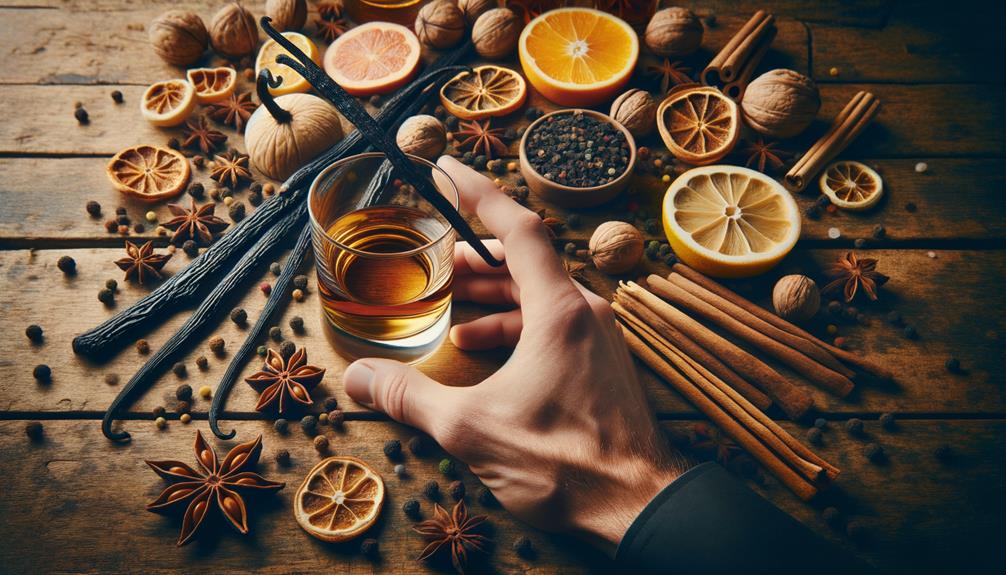
Exploring the complex world of whisky aromas requires a discerning nose that can pinpoint distinct accents. As I delve deeper into the world of whisky, my sense of smell becomes my most trusted ally. By focusing on specific aromatic profiles, I can isolate individual notes like caramel, peat, and smoke.
Whisky's aromatics can be categorized into distinct profiles. I often encounter:
Floral and Fruity aromas, which bring a light, refreshing quality to the whisky, featuring notes of apple, pear, or rose petals.
Spicy and Woody notes, which add depth and warmth, courtesy of cinnamon, nutmeg, and oak.
Caramel and Peat profiles, where aged whiskies reveal rich, sweet scents of caramel and toffee, while peaty whiskies offer earthy, smoky aromas.
The Role of Mouth Breathing
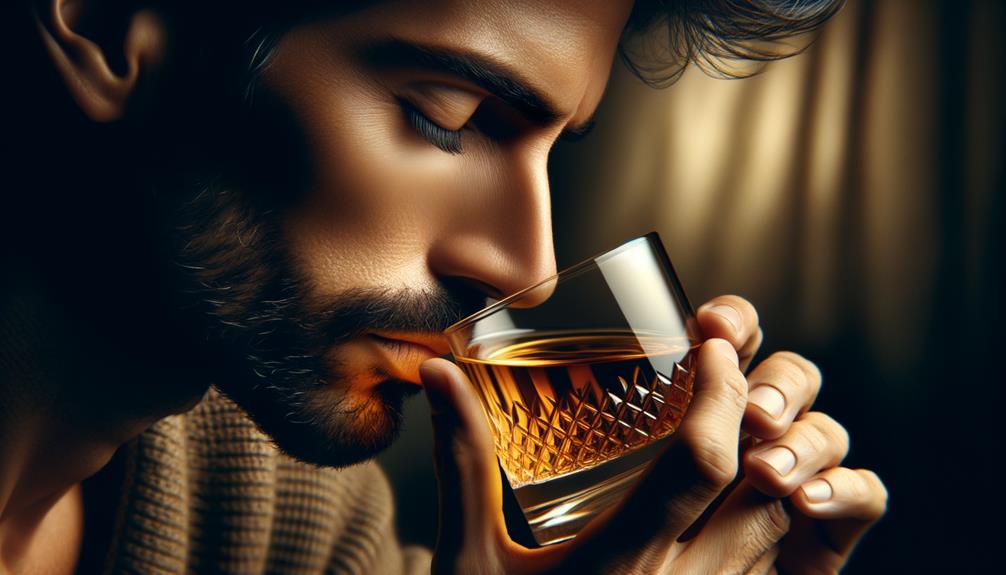
Enhancing Whisky Aromas with Mouth Breathing
When tasting whisky, I've found that mouth breathing helps me appreciate the complex interplay of scents. This technique allows me to mix more air with the volatile compounds, enriching my whisky experience, especially with powerful whiskies that boast intricate profiles. By gently inhaling through my mouth, I can detect layers of aromas that would otherwise remain hidden.
| Technique | Description |
|---|---|
| Mouth Breathing | Inhaling through the mouth to enhance aroma perception. |
| Gentle Inhalation | Ideal for delicate whiskies to capture subtle notes. |
| Deep Sniffing | Effective for powerful whiskies, revealing deeper layers. |
When nosing, I find that mouth breathing integrates more air into the aromas, amplifying their presence without overwhelming my senses. This approach is particularly beneficial for whisky enthusiasts like myself who seek to explore every facet of the whisky's character. Experimenting with different nosing techniques, including mouth breathing, offers varied insights into the whisky's profile.
Engaging in mouth breathing during whisky tasting not only enhances the experience but also allows for a more detailed understanding of both subtle and robust notes. Sharing these techniques with fellow whisky enthusiasts can result in a richer, more informed appreciation of the diverse world of whisky.
Avoiding Scent Contamination
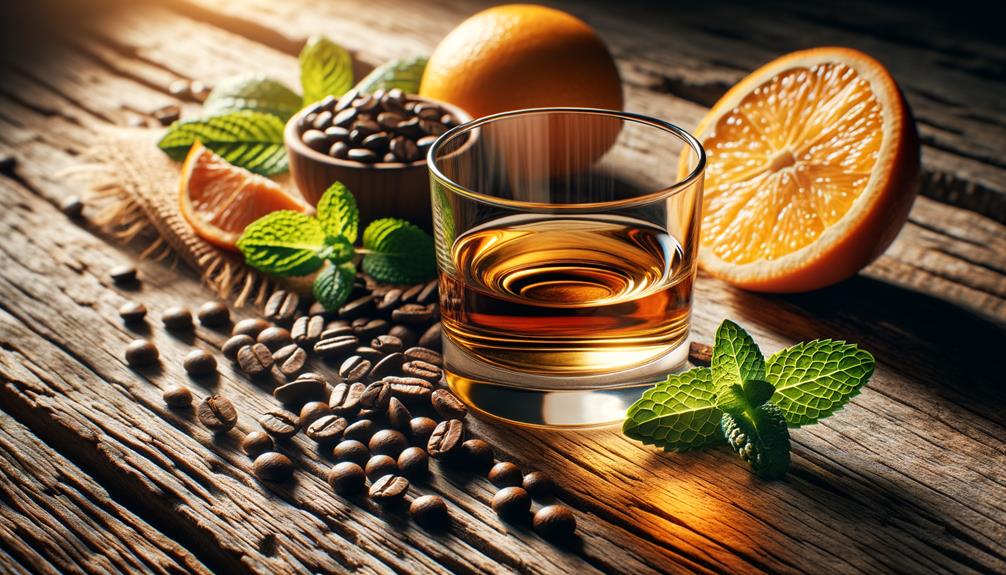
Before I start exploring the world of whisky aromas, I make sure my environment and personal habits are free from any potential scent contamination. To ensure an accurate whisky nosing experience, I follow several meticulous practices.
I always wash my hands with unscented soap to remove any lingering scents that might interfere with the whisky's bouquet. Clean hands are crucial to avoid scent interference.
Next, I rinse my palate with plain water between whiskies. This step is vital to prevent mixing aromas from different whiskies, ensuring each tasting remains distinct and true to its profile.
I also ensure my nosing environment is free from strong odors. I avoid nosing whiskies in rooms with strong cooking smells or scented candles, as these can easily contaminate the fragile aromas of the whisky.
Additionally, I take extra precautions:
- I store whisky glasses away from strong-smelling substances to maintain their neutrality.
- I avoid using scented lotions or perfumes before nosing whisky.
- I use neutral whisky glasses to prevent any scent contamination.
Nosing Multiple Whiskies
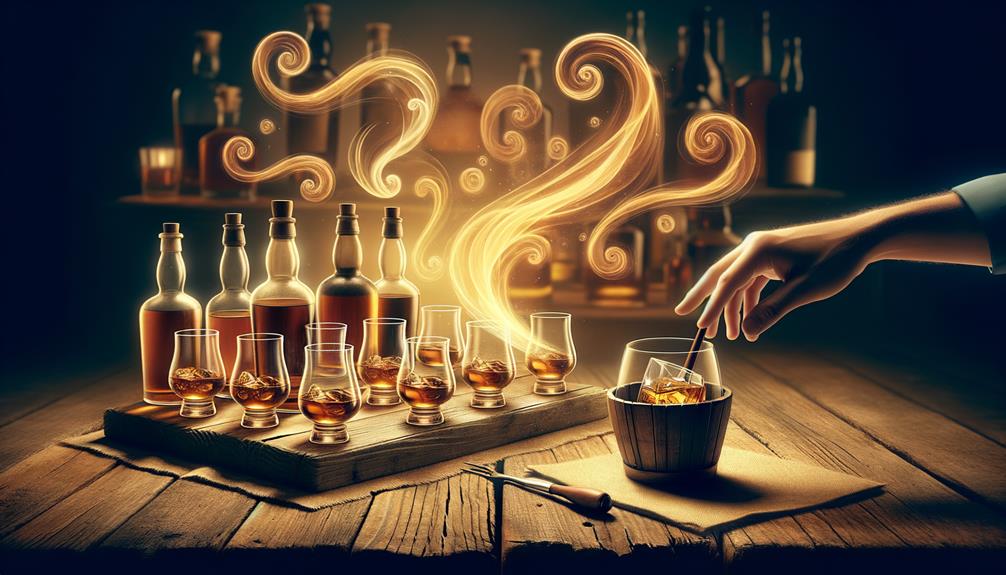
When I'm nosing multiple whiskies, I start with the lighter, more delicate expressions to preserve the subtleties of their flavors. This approach ensures that the bold, robust whiskies don't overpower the lighter ones.
To prevent flavor overlap, I take breaks between nosing to cleanse my palate. A sip of water or a bite of a neutral-tasting cracker works well. Using separate nosing glasses for each whisky is crucial to avoid mixing aromas. Each whisky deserves its own vessel to showcase its unique profile.
As I move from lighter to robust whiskies and finally to the peaty options, I focus on the differences in aromas, noting the various layers and complexities each whisky presents. Experimenting with different nosing techniques, such as short, sharp sniffs or long, deep inhales, helps me uncover the nuances and characteristics of each expression.
Sharing Your Insights

By swapping whisky tasting notes with fellow enthusiasts, I gain fresh perspectives and deepen my appreciation for the intricate aromas each whisky offers. Exchanging nosing techniques and tips with other whisky lovers enriches our collective understanding of whisky tasting.
When I share my own nosing techniques, such as the importance of mouth breathing to enhance the sensory experience, I often receive valuable feedback and alternative methods. For instance, trying the old sniffer method can reveal unique nuances that I might have missed. This exchange of experiences is vital in refining our ability to identify and appreciate the complexities of different whiskies.
To maintain a clear and focused sensory experience, I always avoid cross-contamination of scents, which is a crucial aspect I emphasize during discussions. These collaborative exchanges not only broaden my own nosing repertoire but also foster a deeper connection within the whisky community.
Frequently Asked Questions
How to Train Your Nose for Whisky?
To develop my sense of smell for whisky, I start by familiarizing myself with common scents like coffee and vanilla. I also use aroma kits to refine my skills and keep a detailed journal to track my progress. Joining tasting groups has been instrumental in helping me refine my skills and learn new techniques from others.
How to Get Better at Smelling Whiskey?
To improve my whiskey nosing skills, I've developed a few techniques that have made a big difference. For starters, I make sure to breathe through my mouth, which helps me focus on the aromas. I also use the French Technique, which involves swirling the whiskey in my glass to release the flavors and aromas. Finally, I always clean my nosing glass to ensure I'm getting an accurate sense of the whiskey's characteristics. By following these steps, I've been able to refine my sense of smell and better appreciate the nuances of different whiskeys.
What Is the Breathing Technique for Drinking Whiskey?
The breathing technique for drinking whiskey involves sipping small amounts, letting it coat your mouth, and breathing in through your nose while it's there. As you exhale slowly after swallowing, the whiskey's complex flavors and aromas are revealed.
What Is Whiskey Nosing?
Whiskey nosing is an art that involves savoring the aromas of whiskey to uncover its distinct flavors. As I swirl the glass, bringing it to my nose, I detect layers of flavors ranging from fruity to smoky, which helps me better understand the whiskey's complexity.
Are You Supposed to Swirl Whiskey?
Here's the rewritten text:
I'm a fan of swirling whiskey. You might think it's unnecessary, but it really brings out the complex aromas and flavors. When I observe the legs, I can see the texture and viscosity, which enhances my sensory experience. Swirling aerates the spirit, revealing hidden nuances that I wouldn't have noticed otherwise.

